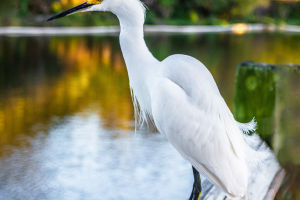With their graceful flight and serene presence, Egrets stand as symbols of elegance among avian species.
They gracefully spread their wings, gliding through wetlands, imparting a sense of freshness and agility to those who behold them.
Among these magnificent creatures, the Snowy Egret stands out as a unique member of the Egret family. Today, let us delve into the Snowy Egret and three other notable species of egrets and marvel at their elegance and allure.
Snowy Egret
Named for its pristine, snow-white plumage, the Snowy Egret epitomizes elegance and grace. Sporting a slender black bill and long legs, this bird boasts an entire body cloaked in glistening white feathers. During breeding seasons, their throats transform, turning a deep shade of black.
Snowy egrets predominantly inhabit wetlands, including swamps, lakes, and rivers, where they adeptly forage in shallow waters, preying upon fish, crustaceans, and insects.
Beyond their enchanting appearance, Snowy Egrets are renowned for their distinctive foraging techniques. Often seen strolling along water edges, they exhibit remarkable agility—extending necks or swiftly thrusting into the water to secure prey.
Moreover, Snowy Egrets congregate in colonies during breeding periods, selecting densely wooded areas to construct nests and rear their offspring.
Great Egret
The Great Egret presents yet another captivating spectacle among the Egret family. The Great Egret boasts a regal demeanour and is slightly larger and taller than its snowy counterpart.
Characterized by its elongated, slender bill and legs and adorned with pristine white plumage, it exudes an air of nobility. Great Egrets inhabit wetlands and rivers worldwide, often gracing birdwatchers with their majestic presence.
Renowned for their adept hunting prowess, Great Egrets are often spotted standing motionless at water's edge, awaiting unsuspecting prey. With lightning-fast lunges, they seize their quarry.
Great Egrets gather in groups during breeding seasons, selecting optimal breeding habitats to engage in courtship rituals and nest-building.
Little Egret
Slightly smaller than the Great Egret yet equally captivating in appearance, the Little Egret possesses its allure.
With a relatively diminutive stature, featuring slightly shorter bills and legs, Little Egrets don soft white plumage, exuding a gentle aura. Preferring lakes, rivers, and swamps, they excel at foraging in shallow waters.
Little Egrets employ similar hunting techniques to their larger counterparts but showcase heightened agility due to their smaller size. During breeding seasons, they, too, form colonies, selecting suitable nesting locations to raise their young.
Cattle Egret
Diverging slightly from the typical egret archetype, the Cattle Egret exhibits feathers tinged with yellow or light brown hues rather than pure white. Aptly named, they often forage for insects atop the backs of cattle, forming a symbiotic relationship with these animals.
Cattle Egrets demonstrate a varied diet, foraging on cattle and grasslands for insects and other small prey.
Despite their distinct appearance, Cattle Egrets boast elegant flight postures and unique foraging methods. During breeding periods, they congregate in colonies, selecting suitable sites for nesting and breeding.
Conclusion
Each of the four egret species possesses distinct characteristics, showcasing its unique charm. While Snowy Egrets captivate with their snow-white plumage and graceful demeanour, Great Egrets, Little Egrets, and Cattle Egrets each enthral with their traits and habits.
As we strive to protect wetland ecosystems, let us not overlook these beautiful avian species. Together, let us ensure the preservation of their habitats, allowing them to soar freely in nature and continue enriching our lives with their beauty and grace.


